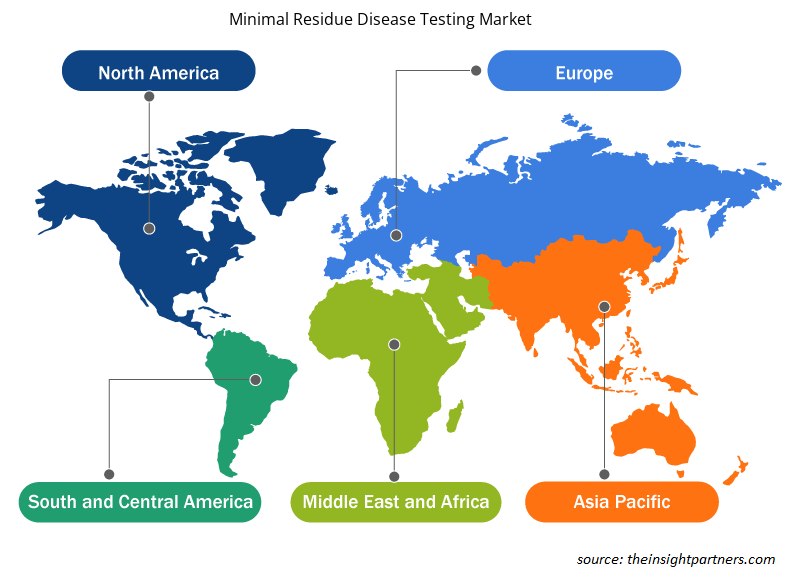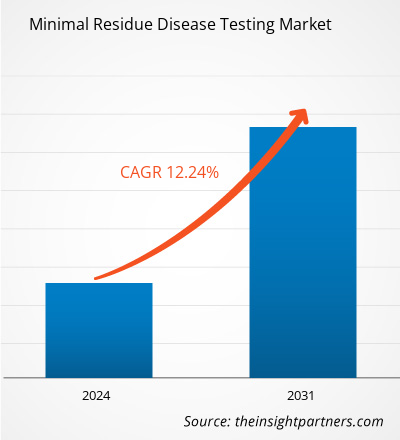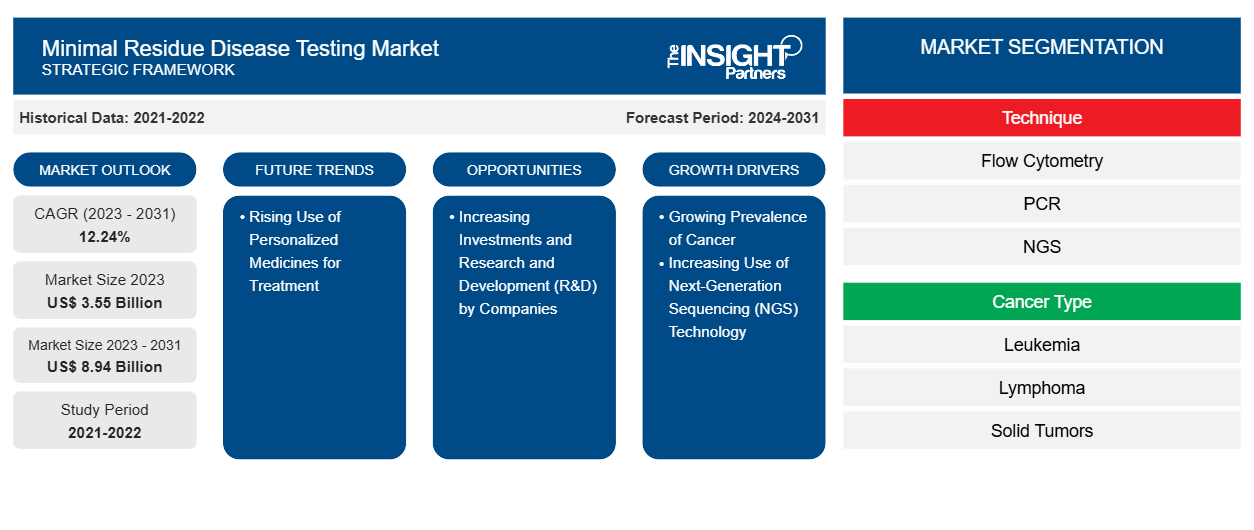최소 잔류 질병 검사 시장 규모는 2023년 35억 5천만 달러에서 2031년 89억 4천만 달러로 급증할 것으로 예상되며, 이 시장은 2023~2031년 동안 12.24%의 CAGR을 기록할 것으로 추산됩니다.
분석가 관점:
이 보고서는 현재 최소 잔류 질병 검사 시장 추세와 예측 기간 동안 예상되는 영향으로 인한 성장 전망을 포함합니다. 백혈병, 림프종, 고형 종양과 같은 다양한 암의 증가하는 세계적 유병률과 최소 잔류 질병 검사 제품 및 서비스에 대한 수요. 의료 서비스 제공자와 연구자는 치료 반응 모니터링, 재발 예측 및 치료적 개입 안내에 최소 잔류 질병 평가의 임상적 유용성을 인식합니다. 최소 잔류 질병 검사가 계속해서 진화하고 암 관리에서 중요한 도구로 부상함에 따라 시장 참여자는 최소 잔류 질병 검사 시장의 수익성 있는 기회를 활용하기 위해 혁신, 표준화 및 접근성에 집중합니다.
시장 개요:
건강 보험 플랜에 최소 잔류 질환 검사를 포함하고 고형 종양 진단에 이 검사 접근 방식을 적용하는 것이 최소 잔류 질환 검사 시장을 주도하는 요인입니다. 최소 잔류 질환 검사에 대한 수요도 전 세계 소비자의 인식이 급증하면서 증가했습니다. 의료 서비스 제공자와 연구자는 이러한 추세를 인식하고 최소 잔류 질환 검사를 임상 실무에 통합하여 환자의 기대에 부응하기 위해 노력합니다. 최소 잔류 질환 검사 시장 성장을 주도하는 다른 주요 요인으로는 암 유병률 증가와 차세대 시퀀싱 기술 사용 증가가 있습니다.
귀하의 요구 사항에 맞게 이 보고서를 사용자 정의하세요
이 보고서의 일부 또는 국가 수준 분석, Excel 데이터 팩을 포함하여 모든 보고서에 대한 사용자 정의를 무료로 받을 수 있으며 신생 기업 및 대학을 위한 훌륭한 혜택과 할인 혜택을 이용할 수 있습니다.
- 이 보고서의 주요 시장 동향을 알아보세요.이 무료 샘플에는 시장 동향부터 추정 및 예측까지 다양한 데이터 분석이 포함됩니다.
시장 동인:
암 유병률 증가로 시장 성장 촉진
2020년 암 발병 건수는 1,930만 건에 달했고, 암 관련 사망자 수는 996만 명에 달했습니다. 국제암연구소에 따르면, 2025년까지 암 발병 건수는 2,190만 건, 2030년까지는 2,460만 건에 달할 것으로 예상됩니다. 미국 임상종양학회의 2021년 2월 보고서에 따르면, 미국에서 성인 약 235,760명(남성 119,100명, 여성 116,6600명)이 폐암 진단을 받았습니다. GLOBOCAN 2020 데이터에 따르면 인도는 전 세계에서 기록된 총 신규 암 발병 건수의 18.3%를 차지했으며, 자궁경부암은 모든 암 발병 건수의 9.4%를 차지했습니다. 미국 암 협회(ACS)에 따르면 2021년 미국에서 위암 신규 환자가 약 26,560명, 남성 16,160명, 여성 10,400명이 발견되었습니다. 2021년 7월 미국 유방암 재단에서 발표한 통계에 따르면 유방암 환자의 약 63%가 국소 단계 유방암으로 진단되었고, 27%가 지역 단계 유방암으로 진단되었으며, 6%가 원격(전이) 질환으로 진단되었습니다. 또한 전 세계적으로 혈액암 유병률이 증가함에 따라 더 나은 치료 옵션과 잔여 암세포 제거의 정확성에 대한 수요가 커지고 있습니다. 미국 암 협회에서 발표한 통계에 따르면 2022년 1월 미국에서 다발성 골수종 신규 환자가 약 34,920명 진단되었습니다. 암 환자 수가 이처럼 급증함에 따라 정부는 새로운 암 예방 프로그램을 시작해야 할 가능성이 높으며, 이는 최소 잔류 질병 검사 시장 성장을 촉진할 것으로 예상됩니다.
세그먼트 분석:
최소 잔류 질병 검사 시장 분석은 기술, 암 유형, 최종 용도라는 부문을 고려하여 수행되었습니다.
기술에 따라 최소 잔류 질병 검사 시장은 유세포 분석, PCR, NGS 및 기타로 세분화됩니다. 유세포 분석 세그먼트는 2023년에 가장 큰 시장 점유율을 차지했습니다. PCR 세그먼트는 2023~2031년 동안 12.39%의 가장 높은 CAGR을 기록할 것으로 추산됩니다. PCR 방법은 돌연변이 또는 염색체 변화와 같은 특징적인 유전적 이상에 따라 암 세포를 검출할 수 있습니다. 이 기술은 필연적으로 작은 DNA 또는 RNA 단편을 증폭하여 검출 가능성과 계수성을 높이는 것을 포함합니다. 이를 통해 희소한 수의 암 세포가 포함된 샘플(예: 혈액 세포 또는 골수)을 사용하여 유전적 이상을 식별할 수 있습니다. PCR의 높은 감도 덕분에 100,000개의 정상 세포 중 단 하나의 암 세포만 검출할 수 있습니다. 검사 결과를 얻는 데 5~14일이 걸릴 수 있습니다.
시장은 암 유형에 따라 백혈병, 림프종, 고형 종양 및 다발성 골수종으로 구분됩니다. 고형 종양 세그먼트는 2023년에 최소 잔류 질병 검사 시장 점유율이 가장 높았습니다. 이 세그먼트의 시장 성장은 고형 종양 환자를 평가하는 데 중점을 둔 진행 중인 연구에 기인합니다. 비혈액학적 악성 종양을 검출하기 위해 MRD 검사를 사용하는 것에 대한 허용된 권장 사항은 없습니다. 고형 종양 치료 후 잔류 분자 질병 진단을 위한 예후 바이오마커로서 순환 종양 DNA(ctDNA)를 포함하는 접근 방식은 임상 시험 설계 및 전환 연구 조사에 빠르게 통합되고 있습니다. 이 접근 방식은 표준 임상 치료에 사용하기에 적합합니다. ctDNA 검출 기술은 빠르게 발전했지만 이러한 검출 방법의 낮은 감도로 인해 다양한 임상 응용 분야에서 MRD를 검출하는 데 유용성이 감소합니다.
최종 사용자를 기준으로 최소 잔류 질병 검사 시장은 병원, 전문 병원, 진단 실험실 등으로 구분됩니다. 병원 부문은 2022년에 최소 잔류 질병 검사 시장 점유율이 가장 높았으며, 2023~2031년 동안 12.79%의 가장 높은 CAGR을 기록할 것으로 예상됩니다. 병원은 시장 점유율이 상당히 높은데, 이는 주로 급성 치료 및 환자 관리에서 병원이 차지하는 역할에 기인합니다. 병원 시설은 더 나은 의사 결정 기능을 제공하여 의사와 의료 전문가가 환자를 분석하고 더 나은 치료 옵션을 제공할 수 있기 때문에 심각한 건강 문제를 겪고 있는 환자에게는 병원 입원이 종종 필요합니다.
지역 분석:
최소 잔류 질병 검사 시장 보고서의 범위에는 북미, 유럽, 아시아 태평양, 중동 및 아프리카, 남미 및 중미가 포함됩니다. 북미 시장은 2023년에 0.93억 달러로 평가되었으며 2031년까지 2.34억 달러에 도달할 것으로 예상되며 2023~2031년 동안 12.12%의 CAGR을 기록할 것으로 예상됩니다. 암 발병률이 크게 증가, 최신 기술 도입, 확립된 프로테오믹스, 유전체학 및 종양학 연구 인프라는 북미가 최소 잔류 질병 검사 시장에 크게 기여하는 국가라는 입지를 공고히 합니다.
아시아 태평양 최소 잔류 질병 검사 시장은 12.68%의 가장 빠른 CAGR을 기록할 것으로 예상됩니다. 특히 인도와 중국과 같은 국가가 있는 이 지역은 상당한 규모의 제약 산업의 본거지입니다. 2021년 10월, Genetron Health(중국)와 Jiangsu Fosun(중국)은 중국에서 MRD 검출 검사를 상용화하기 시작했습니다. 그들은 또한 과거에 중국의 혈액학 중심 병원과 진료소에서 Seq-MRD를 홍보했습니다. 이 검사는 정확성, 높은 처리량, 비용 효율성, 일관성 및 빠른 처리 시간을 제공합니다. 연구는 주요 시장 참여자들이 새로운 검사를 개발하는 주요 초점 분야로 인식됩니다. 연구에 대한 집중도 증가 외에도 치료 후 암 환자를 모니터링해야 하는 급증하는 필요성은 아시아 태평양에서 최소 잔류 질병 검사 시장 진전을 계속 촉진하고 있습니다. 또한 의료 인프라의 개선과 신흥 제약 부문으로 인해 아시아 태평양은 시장의 상당한 성장과 발전을 위한 핵심 허브가 되었습니다.
주요 플레이어 분석:
최소 잔류 질병 검사 시장 보고서에는 Adaptive Biotechnologies, Natera, Bio-Rad Laboratories, F-Hoffmann La Roche Ltd, Guardant Health, LabCorp, Sysmex Corporation, ARUP Laboratories, Invivoscribe, Inc., NeoGenomics Laboratories, Inc., Mission Bio, Inc.가 주요 기업으로 소개되었습니다.
최소 잔류 질병 검사 시장 지역 통찰력
Insight Partners의 분석가들은 예측 기간 동안 최소 잔류 질병 검사 시장에 영향을 미치는 지역적 추세와 요인을 철저히 설명했습니다. 이 섹션에서는 북미, 유럽, 아시아 태평양, 중동 및 아프리카, 남미 및 중미의 최소 잔류 질병 검사 시장 세그먼트와 지리에 대해서도 설명합니다.

- 최소 잔류 질병 검사 시장에 대한 지역별 데이터 얻기
최소 잔류 질병 테스트 시장 보고서 범위
| 보고서 속성 | 세부 |
|---|---|
| 2023년 시장 규모 | 35억 5천만 달러 |
| 2031년까지 시장 규모 | 89억 4천만 달러 |
| 글로벌 CAGR (2023-2031) | 12.24% |
| 역사적 데이터 | 2021-2022 |
| 예측 기간 | 2024-2031 |
| 다루는 세그먼트 | 기술에 따라
|
| 포함된 지역 및 국가 | 북아메리카
|
| 시장 선도 기업 및 주요 회사 프로필 |
|
최소 잔류 질병 검사 시장 참여자 밀도: 비즈니스 역학에 미치는 영향 이해
최소 잔류 질병 검사 시장은 소비자 선호도의 변화, 기술 발전, 제품의 이점에 대한 인식 증가와 같은 요인으로 인해 최종 사용자 수요가 증가함에 따라 빠르게 성장하고 있습니다. 수요가 증가함에 따라 기업은 제품을 확장하고, 소비자의 요구를 충족하기 위해 혁신하고, 새로운 트렌드를 활용하여 시장 성장을 더욱 촉진하고 있습니다.
시장 참여자 밀도는 특정 시장이나 산업 내에서 운영되는 회사나 기업의 분포를 말합니다. 주어진 시장 공간에 얼마나 많은 경쟁자(시장 참여자)가 존재하는지 그 규모나 전체 시장 가치에 비해 나타냅니다.
최소 잔류 질병 검사 시장에서 운영되는 주요 회사는 다음과 같습니다.
- 적응형 생명공학,
- 나테라,
- 바이오라드 연구소,
- F-호프만 라로슈 유한회사,
- 가던트 헬스,
- 랩코프,
면책 조항 : 위에 나열된 회사는 어떤 특별한 순서에 따라 순위가 매겨지지 않았습니다.

- 최소 잔류 질병 검사 시장 주요 주요 업체 개요를 알아보세요
최근 개발 사항:
최소 잔류 질병 검사 시장에서 운영되는 회사는 합병 및 인수를 주요 성장 전략으로 채택합니다. 회사 보도 자료에 따르면, 최근 몇 가지 시장 개발 사항은 다음과 같습니다.
- 2023년 4월 Quest Diagnostics는 Haystack Oncology를 인수하여 고급 액체 생검 기술을 포함하여 종양학 포트폴리오를 확장했습니다. 이 추가로 Quest는 매우 민감한 진단 기능을 갖춘 도구 및 기타 제품을 제공하여 개인화된 암 치료를 개선할 수 있었습니다.
- 2023년 4월, Integrated DNA Technologies는 Archer FUSIONPlex Core Solid Tumor Panel을 출시했습니다. 이 획기적인 테스트 솔루션은 더 광범위한 단일 뉴클레오티드 변형(SNV) 및 indel(즉, 삽입, 삭제 또는 뉴클레오티드 삽입 및 삭제) 기능을 포함하거나 암 연구를 지원하도록 개선되고 개량되었습니다.
- Adaptive Biotechnologies는 2022년 12월 확산성 대형 B 세포 림프종(DLBCL) 환자에서 순환 종양 DNA(ctDNA)를 사용하여 최소 잔류 질병을 평가하는 clonoSEQ를 출시했습니다.
- 2022년 10월, Adaptive Biotechnologies와 Epic Systems Corporation은 clonoSEQ 분석을 Epic의 포괄적인 전자 의료 기록(EMR) 시스템에 통합하기 위해 협력했습니다. clonoSEQ 분석은 다발성 골수종(MM), 만성 림프구성 백혈병(CLL) 및 B세포 급성 림프모구 백혈병(ALL)과 관련된 최소 잔류 질환을 탐지하기 위해 미국 식품의약국(FDA)에서 모니터링 및 승인되었습니다.
- 로슈는 2022년 8월, 특정 RNA 및 DNA의 미량 원소를 정확하게 정량화하도록 설계된 최초의 디지털 LightCycler 시스템을 출시했습니다.
- 2022년 2월, Personalis는 Moores Cancer Center와 협력하여 진행성 고형 종양 및 혈액 악성 종양이 있는 환자의 임상 진단 검사를 지원했습니다. 이 협력은 새롭게 도입된 액체 생검 검사를 사용하여 매우 민감한 최소 잔류 질환 및 암 재발을 탐지하기 위한 연구를 수행하는 데 중점을 두었습니다.
- 과거 분석(2년), 기준 연도, CAGR을 포함한 예측(7년)
- PEST 및 SWOT 분석
- 시장 규모 가치/거래량 - 글로벌, 지역, 국가
- 산업 및 경쟁 환경
- Excel 데이터세트
최근 보고서
관련 보고서
사용 후기
구매 이유
- 정보에 기반한 의사 결정
- 시장 역학 이해
- 경쟁 분석
- 고객 인사이트
- 시장 예측
- 위험 완화
- 전략 기획
- 투자 타당성 분석
- 신흥 시장 파악
- 마케팅 전략 강화
- 운영 효율성 향상
- 규제 동향에 발맞춰 대응





















 무료 샘플 받기 - 최소 잔류 질병 검사 시장
무료 샘플 받기 - 최소 잔류 질병 검사 시장